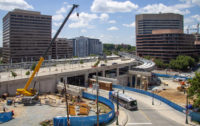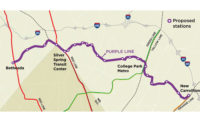Transit Construction
Stalled Maryland Light-Rail P3 Won't Open Until 2026, With Cost Up $1.4B

Completion of Maryland’s stalled Purple Line light rail project now is set for fall 2026—more than four years past the March 2022 planned operating date—and with total design and construction cost rising to $3.4 billion, up $1.4 billion from its original budget, state officials said.
The state’s three-member Board of Public Works approved on Jan. 26 the proposed contract between Purple Line Transit Partners (PLTP), the private consortium managing the Purple Line for the Maryland Dept. of Transportation under the project's public-private partnership approach, and U.S. units of Spanish contractors Dragados and OHL
The construction cost for the 16-mile, 21-station system across Washington, DC’s northern suburbs also includes about $1.1 billion already spent since construction originally began in mid-2017.
The oversight board, which includes Gov. Larry Hogan (R), also approved MDOT’s revised financial agreement with PLTP that increases the construction, finance and 30-year operations concession from $5.6 billion to $9.3 billion, as well as $15 million for a state consultant to oversee construction details.
Also approved was $15.4 million in contracts to complete utility and stormwater work managed by the state since a team led by Fluor Corp., Lane Construction Corp. and Traylor Bros. withdrew from the project in October 2020 following a long-running dispute over responsibility for delays and nearly $1 billion in cost overruns.
Pending financial close, full construction on the Purple Line would resume this spring.
PLTP selected the Dragados-OHL team last November to take over the half-finished Purple Line after a team led by Fluor Corp., Lane Construction Corp. and Traylor Bros. withdrew from the project in October 2020 following a long-running dispute over responsibility for delays and nearly $1 billion in cost overruns.
The state has since managed a scaled-back construction effort while PLTP sought a new contractor.
According to MDOT, the Dragados-OHL contract price incorporates the additional financial risk of completing a project already underway. Agency officials also say the project’s existing environmental permits and ongoing utility relocation work will reduce the risk of future cost overruns.
MDOT has also resolved a construction-phase design change that added a wall to separate Purple Line and CSX freight rail tracks. That issue had inflamed what was already a contentious relationship between MDOT and the original construction team.
The revised public-private partnership agreement with PLTP increase covers the additional construction costs, a $250-million legal settlement already paid to the Fluor-led team and anticipated higher debt service payments. In addition, Maryland’s annual payments to PLTP will rise from an average of $154 million to $240 million.
“Despite the challenges over the last several years, we have never lost sight of the benefits of the Purple Line for the residents and businesses in the National Capital Region,” said Holly Arnold, head of MDOT’s Maryland Transit Administration unit. She assumed the agency top role last November after serving as deputy, and is a former transportation analyst for engineer-constructor CH2M, now a unit of Jacobs.




